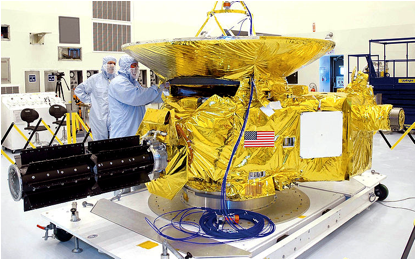Radioisotope Thermoelectric Generators
One major challenge for the power system is providing power to the relay spacecraft that are being used to relay the signal from the satellite in Epsilon Eridani back to Earth. While the satellite has an abundant source of solar energy, the relays are in the middle of empty space. The solution to this is to use radioisotope thermoelectric generators, or RTGs, which use radioactive isotopes to generate heat. Energy is generated by using this heat to affect an array of thermocouples, which are junctions between two different metals. The temperature gradient between the different metals results in voltage between them as well, and if the circuit is closed there is a continuous current. This principle is known as the Seebeck effect and is the means by which RTGs generate power.
Since the power from RTGs comes from radioactive decay, the power output will slowly decline, reaching 50% output when the radioactive material reaches its half-life. Luckily the typical half-life is pretty long, such as 87.7 years for the commonly used Plutonium-238 isotope. This continuous source of power and very long lifetime make RTGs ideal for deep space missions, and they have been used frequently in probes such as Voyager 1 and 2 as well as newer ones such as New Horizons. The main advantages are the reliability, since power is constant with no interruptions, and the fact that no outside energy is need such as solar radiation. The main disadvantage is that the power output is much lower than that of solar cell arrays, usually in the hundreds of watts. Multiple RTGs are often used to increase power output. Figure 1 below shows a diagram of a typical radioisotope thermoelectric generator.

Figure 1. Cutaway diagram of a radioisotope thermoelectric generator.
For our mission and the sending of relay spacecraft to Epsilon Eridani, an RTG will be needed that lasts much longer than Plutonium-238. The solution is to use Americium-241, which has a half-life of 432 years. Although it has less power density than Pu-238, Am-241 has been determined to be one of the best candidates for long term space missions. Though the power drops over the time period, an Am-241 RTG is expected to last for about 1000 years. Using a large amount of the Am-241 material, we will create RTGs that last for 1000 years and begin with a power output of 1 kW. By the time a relay reaches the distance necessary to communicate, the RTG should be close to its half-life and provide a power of 500 W. Additionally, multiple RTGs can be used to achieve a higher total power output.

Figure 2. New Horizons probe launched in 2006 with RTG protruding from the left.